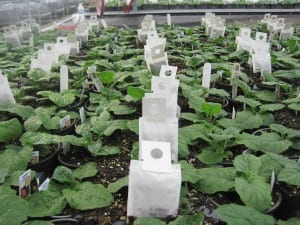More Connecticut greenhouse growers and retailers are using biological controls to manage insect and diseases (Photo of greenhouse). Here you can see a variety of spring plants for sale that were grown using biological controls (beneficial insects and mites, and biologically based fungicides). As an example, this yellow gerbera daisy flower was grown using biological controls. (yellow gerbera daisy). This is to prevent damage from western flower thrips that can damage flowers (pink gerbera daisy). Small predatory mites (photo of bags in plants) are placed in the crop that prey upon the small thrips in the flowers. Here the predatory mites are contained inside a controlled release sachet containing bran and a additional food source for the beneficial mites. The small predatory mites emerge from these small paper sachets over a 4 to 6 week period preying upon western flower thrips. (Note: western flower thrips are primarily a concern in greenhouse production, not in the home garden). Source: Leanne Pundt, UConn Extension Educator in Greenhouse IPM.



